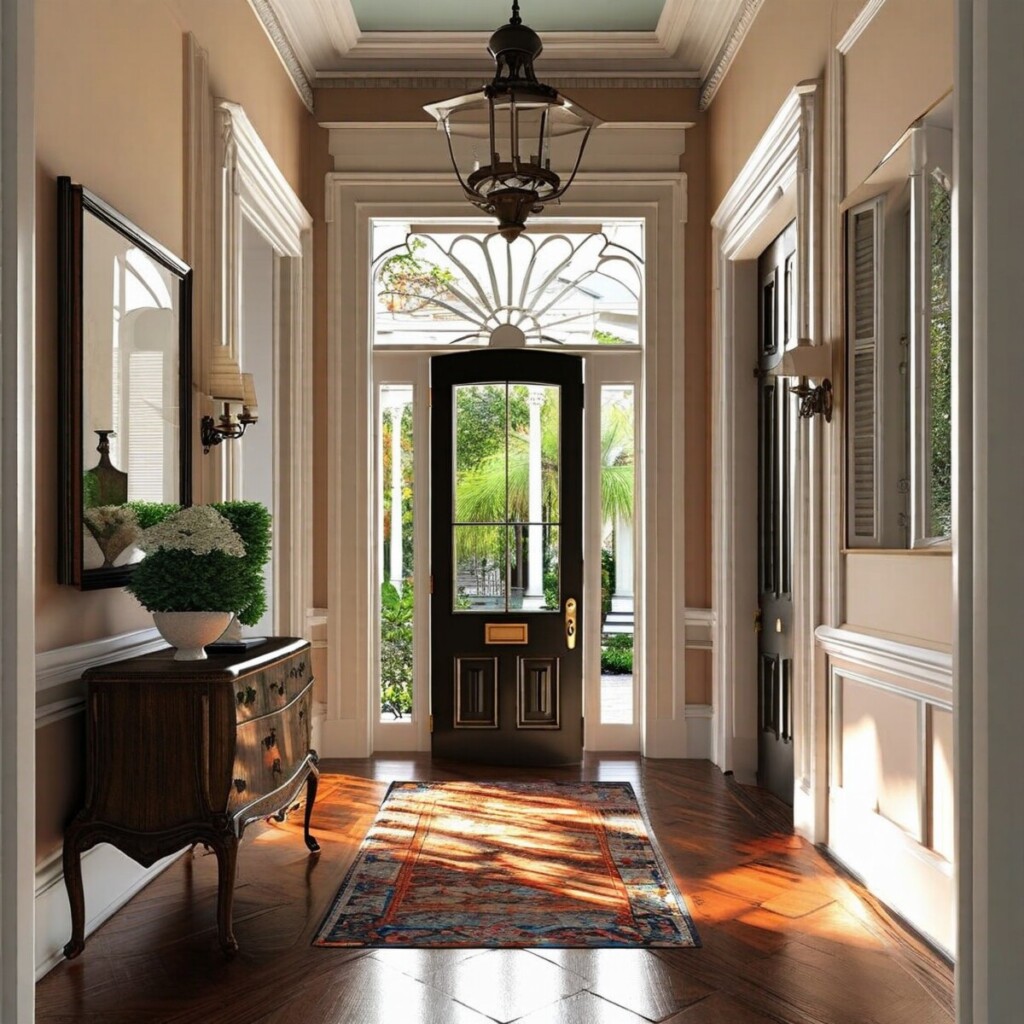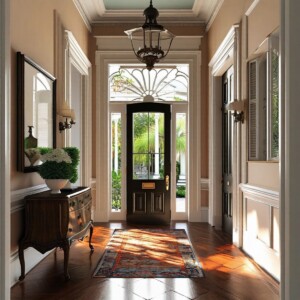Design Through the Decades: 14 Vintage Home Trends from the 1920s to 1940s That Still Look Amazing


Experts share how to bring vintage charm into your home with standout design elements from the 1920s, ’30s, and ’40s.
The 1920s through 1940s were all about elegance and intention. Interiors from this era combined bold design with functionality – think curving lines, geometric patterns, built-ins, and rich materials like wood, brass, and velvet.Whether you’re redesigning a historic home in New Orleans or hoping to add more character to a sleek apartment in Philadelphia, this era offers plenty of inspiration. We asked design experts to share their favorite ways to bring vintage style into modern spaces, here’s how to get the look.

1. Incorporate curves, glass, and metallic accents
“The speed lines and curving contours of 1920s and ’30s Art Deco design infuse modernist minimalism with an elegance redolent of high society, glamour, and celebrity,” informs Vince, an expert in historic architecture from Vince Michael. “Almost a century later, curving walls of glass block, stacked pylons, and ribbed cornices still convey elegance and sophistication. You often see this echoed in subway tile backsplashes, shower stall speed lines, and circular or oval accent mirrors with beveled edges.”
2. Blend form and function with built-ins and geometric details
“Design from the 1920s to 1940s carries a quiet elegance—built-ins, geometric lines, and natural materials that reflect a deep sense of purpose,” advises Henry from the Frank Lloyd Wright Foundation. “These details echo Frank Lloyd Wright’s vision of organic architecture, where every element serves a function and responds to its surroundings. Built-ins remain a beloved feature, often reinterpreted today to create spaces that feel both grounded and fluid. When balanced thoughtfully with modern design, these vintage touches bring warmth, clarity, and a sense of belonging to the spaces we live in.”
3. Bring vintage charm through color and character
“We love the elegance of 1920s–1940s design—especially the curved lines, elegant bar carts, and tufted sofas,” says Christina Samatas and Renee DiSanto, founders of Park & Oak. “The rich mix of gold, oranges, and blues is still popular today, and gold accents are making a strong comeback. Floral patterns, ruffles, and scalloped edges from the 1940s are also trending again, bringing vintage charm into modern spaces.”
4. Mix bold details and natural finishes
“I love how 1920s–1940s design brings warmth and character to homes, especially with the use of natural wood finishes that are often missing in modern contemporary designs. As an interior designer,” says Kanika, Principal Interior Designer, Kanika Design, “I really enjoy using different types of moldings in bold colors, which add drama and a touch of vintage charm. One of my favorite timeless features is a black and white checkerboard floor—it’s a classic look that I often recommend to clients for remodeling projects because it complements modern interiors beautifully. Mixing these vintage elements creates a balanced space that feels both fresh and full of personality.”
5. Use patterns for timeless glamour
“Art Deco was a popular style during the Roaring Twenties and is one of our favorites,” mentions Shirin from And Academy. “It featured bold, geometric patterns and luxurious materials to create glamorous, high-impact interiors. Its brilliant use of sharp lines and stylized motifs—combined with sleek furniture—results in a look that feels timeless.
In modern interior design, incorporating geometric patterns with a hint of metallic accents can make the perfect statement for homeowners looking to blend sophistication with a touch of old-school glamour.”

6. Preserve original details whenever possible
“I’m a hard-core retro enthusiast and renovated my kitchen entirely in 1920s/30s style, with only a small apartment-size dishwasher added for convenience,” says Therese Poletti Author/Journalist at Timothy Pflueger. “All my light fixtures are either rewired originals or high-quality reproductions.”
What I often see in modern remodels—painted-over wood, generic fixtures, and the removal of original details—really upsets me,” Therese continues. “So much character gets lost in the process. It is possible to upgrade a home without stripping away its history. I recently toured a Spanish Colonial in Berkeley that had its vibrant bathrooms and original charm replaced with sterile white and gray interiors—it looked clean, but the soul was gone.”
7. Embrace California Spanish Revival style
“In Malibu, California, homes built between the 1920s and 1940s showcase the classic early California Spanish design,” Brian Merrick, a Malibu Real Estate Agent shares. “These residences feature red tile roofs, white or earth-toned plaster walls, and charming interior courtyards. Intricate wood and wrought iron details add character, while arched windows and vibrant tile work on countertops and floors enhance their timeless appeal. This architectural style remains as enduring and sought-after today as it was a century ago.
8. Reimagine vintage elements for modern homes
Styldod mentions, “We love how the 1920s–1940s design era blended bold artistry with timeless elegance. The geometric precision of Art Deco, the rich color palettes of the 1930s, and the organic sophistication of 1940s Art Nouveau continue to inspire modern interiors. We often incorporate checkerboard flooring in softer hues, brass and chrome accents for a refined yet contemporary touch, and built-in shelving to add both character and functionality. These vintage elements, when reimagined through the lens of today’s open layouts and minimalist sensibilities, create spaces that feel both nostalgic and effortlessly stylish
9. Let design reflect both past and present
“The way architectural styles from different eras can complement and enhance one another is truly fascinating,” says Susan Edwards from Architect Builder Group. “Incorporating elements from the past into modern design brings a sense of history and character to contemporary spaces, while still offering the functionality and comfort we value today.
For example, the 1920s to 1940s offer a unique blend of Art Deco’s bold geometry that pairs beautifully with the clean lines and open layouts of modern homes. Or consider how rustic, handcrafted elements from Craftsman design—like exposed rafters and built-ins—can be balanced with lighter palettes and updated materials to respect the past while refreshing the space. This thoughtful mix often creates a timeless look that feels both current and rooted in heritage. It’s like a conversation between eras—and it’s one we love being part of.”
10. Highlight architectural details for depth and dimension
“I absolutely love the architecture and design from the 1920s to 1940s. I actually live in a home built in 1920 and appreciate the thoughtful details throughout,” Libby Rawes from Sharp & Grey Interiors mentions.”My favorite elements are the various types of molding—substantial baseboards, stairwells with unique trim, and the use of crown molding, wainscoting, chair rails, and other features that add depth and dimension.
I’m a big fan of incorporating architectural detail into every design. When working in an older home, I always preserve its original charm, and in newer homes, I intentionally add character to give the space some soul. From walls and staircases to cabinetry, these touches help create that timeless, old-world feel.”

11. Use bold materials and strong lines
“What stands out about 1920s–1940s design is the mix of elegance and bold geometry,” recommends Valentina Urban, Designer at LiLi Tile. “Even during challenging times like the Great Depression, interiors were rich in detail, strong lines, and quality materials—a style that still resonates today.”
“At LiLi Tile, we bring this era into the present through our Elite collection, which combines brass and cement for an industrial yet glamorous look. We also use signature Art Deco geometry and colors—deep teals, browns, and soft blush tones—in many of our patterns. Even small details like geometric lighting or vintage decor can add character and create a timeless, balanced space.”
12. Play with grid patterns and luxe finishes
Susan Bednar Long from S. B. Long Interiors says, “When I think of interior design from the 1920s–1940s, I think of exotic woods, rich fabrics, streamlined silhouettes, metallic accents, and—most of all—geometric and grid patterns. Inspired by French designers Jean-Michel Frank and Pierre Chareau, I often incorporate graphic grids into my projects.
In a recent primary bathroom, I designed a bronze metal-framed glass shower wall in a bold grid pattern, paired with hand-glazed soft blue square tiles stacked on the walls and floor. The look is elegant, yet utilitarian. This grid theme continues throughout the apartment—with brass-framed kitchen cabinetry, end-cut oak flooring laid in a square grid, and rectangular suede wall panels in the primary bedroom separated by bronze reveals. These elements are modern but rooted in the timeless elegance of the era.”
13. Add personality through furniture and color
“One of my favorite aspects of furniture and interior design from the 1920s to 1940s is how colorful and elegant they are,” says Kimberly Que of FROY. “Many popular interior styles today lean too heavily on neutral tones—I’m looking at you, modern farmhouse—which can result in homes that feel generic and lack personality. By contrast, design styles that flourished in the 1930s, like Art Deco and Hollywood Glam, are vibrant and contemporary. Introduce a table, couch, or chair inspired by these vintage-modern styles to bring in colors like gold, china blue, mauve, seafoam, and other misty shades—often showcased in sleek geometric or curved forms.”
14. Don’t be afraid to go bold
“I tend to go as bold as the space allows, using jewel tones in accessories, wallpaper, and art, along with wide crown molding and furniture with curved edges,” says Holly Kalisher from HK Interiors. “My focus is on pieces with structure and strong design that serve the space. This era was forward-thinking—minimalist in its time—and many elements still work today. For example, Art Deco light fixtures pair well with smart bulbs, and vintage furniture shapes can be refreshed with high-gloss or shimmering finishes.”
The post Design Through the Decades: 14 Vintage Home Trends from the 1920s to 1940s That Still Look Amazing appeared first on Redfin | Real Estate Tips for Home Buying, Selling & More.




